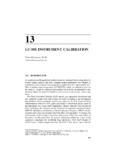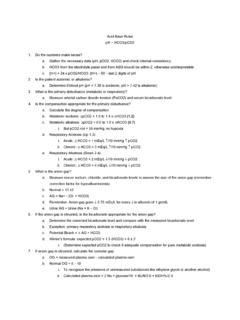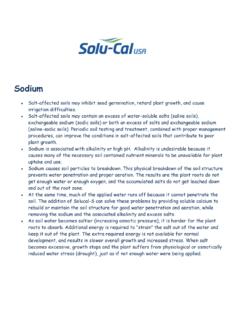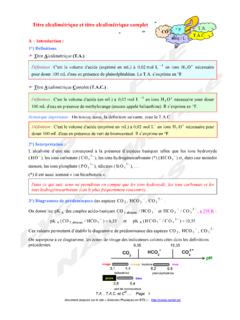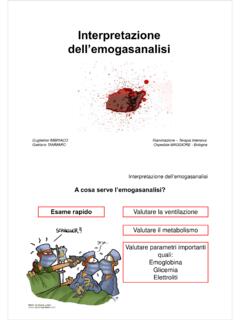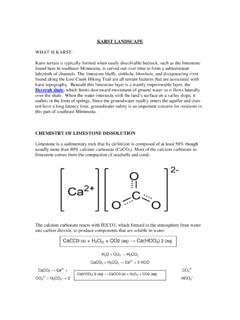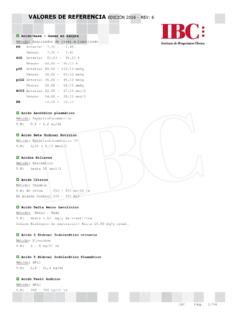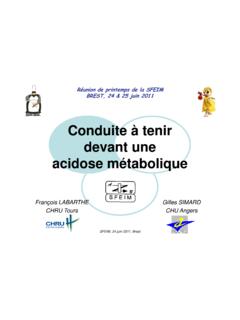Transcription of PCO2 AND CALCULATED VALUES FOR HCO3, …
1 pco2 AND CALCULATED VALUES FOR hco3 , tco2 , BASE EXCESS AND ANION GAPArt: 714182-00 FRev. Date: 08/27/03 pco2 is measured by direct potentiometry. In the calculation of results for pco2 , concen tration is re lat ed to potential through the Nernst equation. Results are measured at 37 C when using car tridg es that require thermal control and corrected to 37 C when using cartridges that do not require thermal ValuesWhen a cartridge includes sensors for both pH and pco2 , bicarbonate ( hco3 ), total carbon di ox ide ( tco2 ) and base excess (BE) are hco3 = pH + log pco2 = hco3 + pco2 BEecf= hco3 + (pH )BEb = (1 - *Hb) * [ hco3 - + ( * Hb + ) * (pH - ) ]When a cartridge includes sensors for sodium, potassium, chloride, pH and pco2 , anion gap can be Gap = (Na + K) (Cl + hco3 )See below for information on factors affecting results.
2 Certain substances, such as drugs, may af fect analyte levels in If results appear inconsistent with the clinical assessment, the patient sample should be retested using another UseThe test for pco2 , as part of the i-STAT System, is intended for use in the in vitro quantification of carbon dioxide partial pressure in ar te ri al, venous, or capillary whole i-STAT cartridge contains one reference electrode (when potentiometric sensors are included in the cartridge configuration), sensors for the measurement of specific analytes, and a buffered aqueous calibrant solution that contains known concentrations of analytes and preservatives. For cartridges that contain a sensor for the measurement of pco2 , a list of reactive ingredients is indicated below:Carbon Dioxide (CO2)Metrological TraceabilityThe i-STAT System test for carbon dioxide partial pressure measures carbon dioxide partial pressure in arterial, venous, or capillary whole blood (dimension kPa) for in vitro diagnostic use.
3 pco2 VALUES assigned to i-STAT s controls and calibration verification materials are traceable to National Institute of Standards and Technology (NIST) standard reference materials via commercially available certified specialty medical gas standards. i-STAT System controls and calibration verification materials are validated for use only with the i-STAT System and assigned VALUES may not be commutable with other methods. Further information regarding metrological traceability is available from i-STAT : 714182-00F Rev. Date: 08/27/03 Expected VALUES Reportable ReferenceTest/AbbreviationUnits*Range Range (arterial) (venous)Partial Pressure Carbon Dioxide/PCO2mmHg5 13035 453 41 8522 26** 23 28**Total Carbon Dioxide/TCO2mmol/L1 8523 27** 24 29**Base Excess/BEmmol/L(-30) (+30)(-2) (+3)3 (-2) (+3)3 Anion Gap/AnGapmmol/L(-10) (+99)10 203 10 203*The i-STAT System can be confi gured with the pre ferred units.
4 ** CALCULATED from Siggaard-Andersen tco2 , VALUES measured on serum or plasma by chemistry analyzers may be slightly lower than tco2 CALCULATED from pH and pco2 due to loss of CO2 during non-anaerobic Up to 6mmol/L CO2 can be lost per hour by exposure of the sample to convert pco2 results from mmHg to kPa, multiply the mmHg value by reference ranges programmed into the analyzer and shown above are intended to be used as guides for the interpretation of results. Since reference ranges may vary with demographic factors such as age, gender and heritage, it is recommended that reference ranges be determined for the pop u la tion being SignificancePCO2 along with pH is used to assess acid-base balance. pco2 (partial pressure of carbon dioxide), the respiratory component of acid-base balance, is a measure of the tension or pressure of carbon di ox ide dissolved in the blood.
5 pco2 represents the balance between cellular production of CO2 and ven ti la to ry removal of CO2 and a change in pco2 indicates an alteration in this balance. Causes of primary respiratory acidosis (increase in pco2 ) are airway obstruction, sedatives and an es thet ics, res pi ra to ry distress syndrome, and chronic obstructive pulmonary disease. Causes of pri ma ry res pi ra to ry alkalosis (decreased pco2 ) are hypoxia (resulting in hyperventilation) due to chronic heart failure, edema and neurologic disorders, and mechanical (bicarbonate), the most abundant buffer in the blood plasma, is an indicator of the buff er ing capacity of blood. Regulated primarily by the kidneys, hco3 is the metabolic component of acid-base balance. Causes of primary metabolic acidosis (decrease in hco3 ) are ketoacidosis, lac tate ac i do sis (hy poxia), and diarrhea.
6 Causes of primary metabolic alkalosis (increase in hco3 ) are vom it ing and antacid (total carbon dioxide) is either measured on plasma by automated chemistry analyzers or is cal cu lat ed from pH and pco2 measured on whole blood gas analyzers. tco2 is a measure of car bon dioxide which exists in several states: CO2 in physical solution or loosely bound to pro teins, hco3 or CO3 ions, and carbonic acid (H2CO3). Bicarbonate ions make up all but ap prox i mate ly 2 mmol/L of the total carbon dioxide of plasma. Measurement of tco2 as part of an electrolyte profile is useful chiefly to evaluate hco3 concentration. tco2 and hco3 are useful in the assessment of acid-base im bal ance (along with pH and pco2 ) and electrolyte excess of the extracellular fluid or standard base excess is defined as the concentra tion of ti trat able base minus the concentration of titratable acid when titrating the av er age intracellular flu id (plasma plus interstitial fluid) to an arterial plasma pH of at pco2 of 40 mmHg at 37 C.
7 Excess concentration of base in the average ECF re mains virtually constant during acute changes in the PCO2and reflects only nonrespiratory component of Date: 08/27/03 Art: 714182-00 FAnion gap is reported as the difference between the commonly measured cat ions sodium and po tas si um and the commonly measured anions chloride and bicarbonate. The size of the gap re flects unmeasured cations and anions and is therefore an analytical gap. Physiologically, a deficit of anions cannot ex ist. While rel a tive ly nonspecific, anion gap is useful for the detection of or gan ic acidosis due to an increase in anions that are difficult to measure. An ion gap can be used to classify metabolic ac i do sis into high and normal an ion gap types. An ion gap may be only slight ly increased in diarrhea and re nal failure, but el e vat ed (often >25) due to an increase in or gan ic anions in lactic acidosis, ketoaci dosis (alcoholic, diabetic, starvation) and uremia, an in crease in in or gan ic anions in uremia, and an increase in anions from drugs such a sal i cy late and carbenicillin or toxins such as methanol and CharacteristicsThe performance characteristics of the sensors are equivalent in all cartridge typical performance data summarized below was collected in a health care facility by health care professionals trained in the use of the i-STAT System and comparative data were col lect ed in multiple sites as follows.
8 Duplicates of each control fluid were tested in the morning and in the afternoon on five days for a total of 20 replicates. The averaged statistics are presented below. Method com par i son data were collected using NCCLS guide line EP9-A7. Venous blood sam ples were col lect ed in blood gas syringes. To measure tco2 , the sample was centrifuged to obtain plasma. All samples were analyzed in duplicate on the i-STAT Sys tem and on the comparative meth ods within 10 min utes of each other. Arterial blood samples were collected from hospital patients in 3cc blood gas syringes and were analyzed in duplicate on the i-STAT System and the comparative method within 5 minutes of each other. Deming regression analysis8 was per formed on the first replicate of each sam ple. In the method com par i son ta ble, n is the number of specimens in the data set, Sxx and Syy refer to es ti mates of im pre ci sion based on the duplicates of the comparative and the i-STAT methods respectively, is the standard error of the estimate, and r is the cor re la tion coefficient.
9 *Method comparisons will vary from site to site due to differences in sample han dling, comparative method calibration and other site specific variables. * The usual warning relating to the use of regression analysis is summarized here as a reminder: For any analyte, if the data is collected over a nar row range, the estimate of the regression parameters are relatively imprecise and may be biased. Therefore, predictions made from these es ti mates may be invalid .7 The correlation co ef fi cient, r, can be used as a guide to assess the adequacy of the com par a tive method range in over com ing this problem. As a guide, the range of data can be considered adequate if r> Data (mmHg)Aqueous ControlMeanSD%CVLevel : 714182-00F Rev. Date: 08/27/03 Method Comparison (mmHg) pco2 IL BGETCO2 IL BGETCO2 Beckman CX 3 pco2 Radiometer Affecting Re sults*Exposing the sample to air allows CO2 to escape which causes pco2 to de crease and pH to increase and hco3 and tco2 to be under-estimated.
10 The use of partial-draw tubes (evacuated tubes that are adjusted to draw less than the tube volume, a 5 mL tube with enough vacuum to draw only 3 mL) is not recommended for use with the i-STAT System because of the potential for decreased mea sured pco2 results and CALCULATED hco3 and tco2 VALUES . Under-filling blood collection tubes may also cause decreased pco2 results. Care must also be taken to eliminate bubbling of the sam ple with a pipette when filling a cartridge to avoid the loss of CO2 in the blood to stand (without exposure to air) before testing allows pco2 to increase and pH to decrease, which will cause hco3 and tco2 to be over-estimated, due to metabolic : When using Type B cartridges (cartridges without a or on the pouch and box) with either SIMS Portex Dry Line Draw arterial blood gas sampling syringes with dry lithium heparin or SIMS Portex Anaerobic Line Draw arterial blood gas sampling syringes with liquid sodium heparin, ensure that the syringe lot number is 107xxx or higher.
